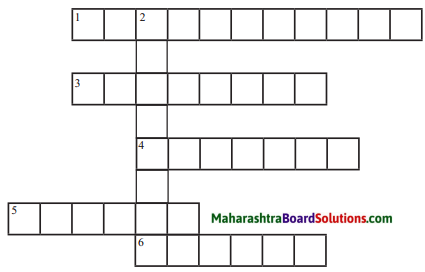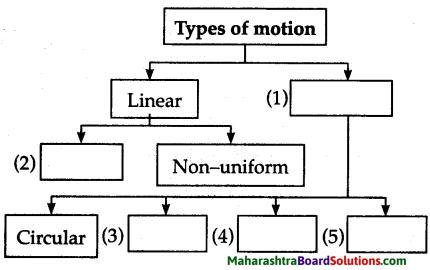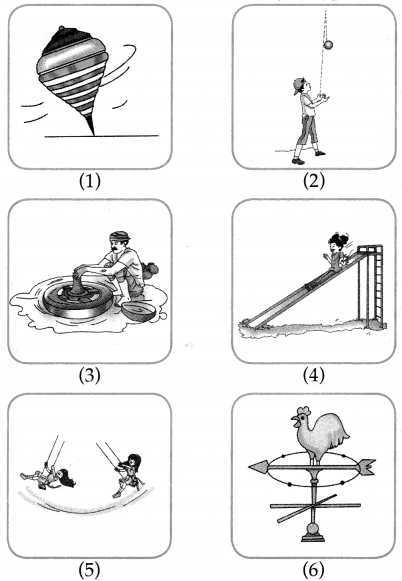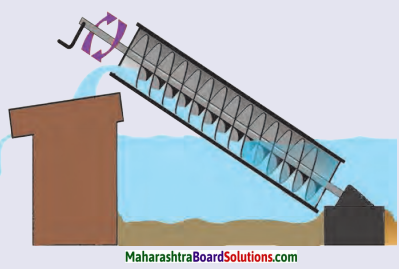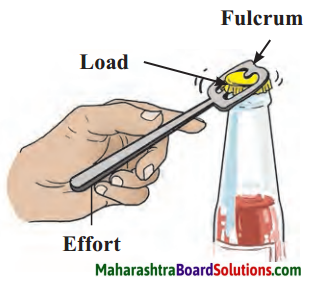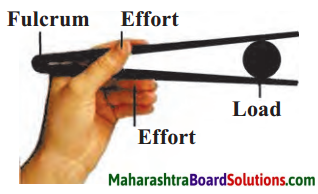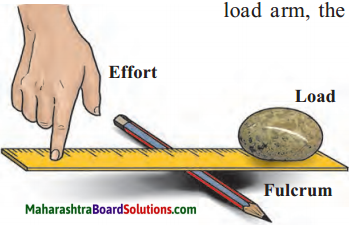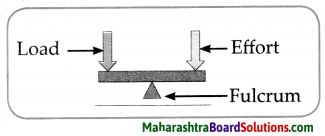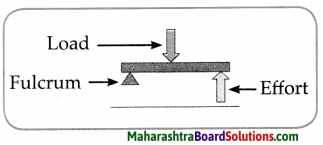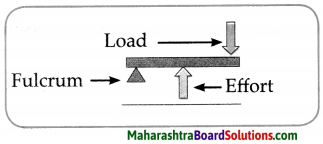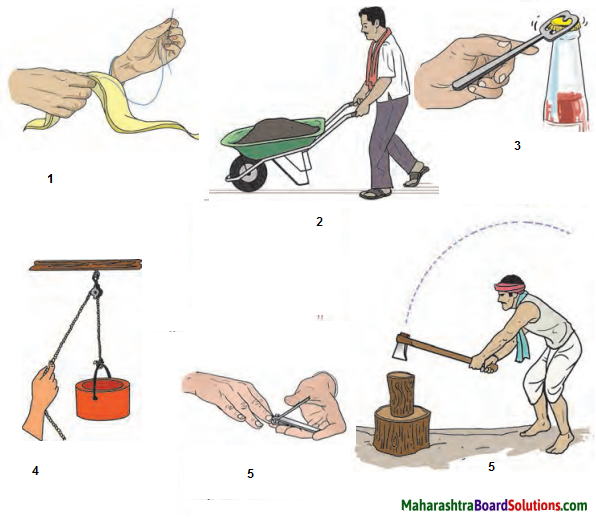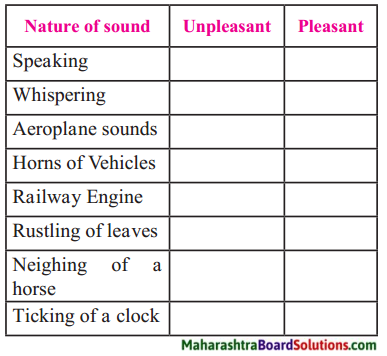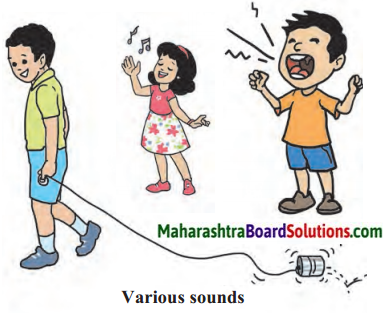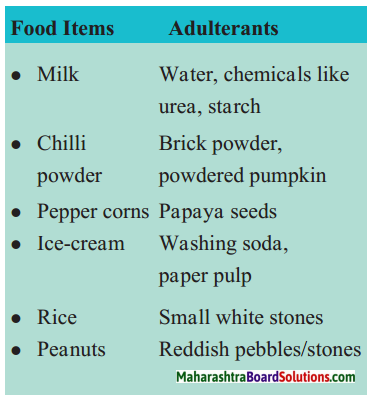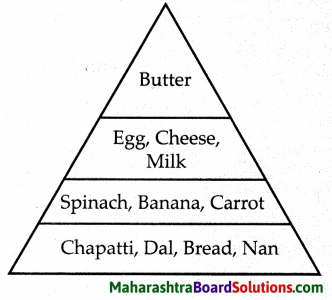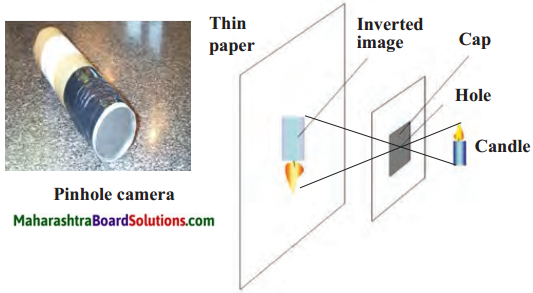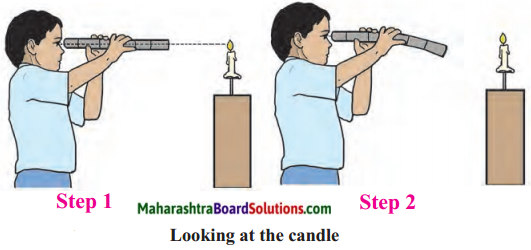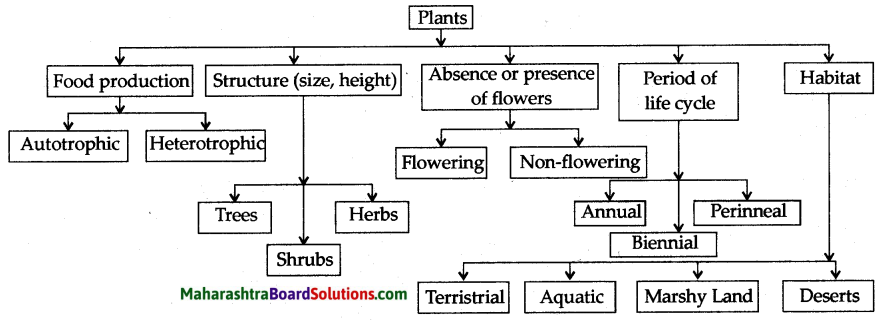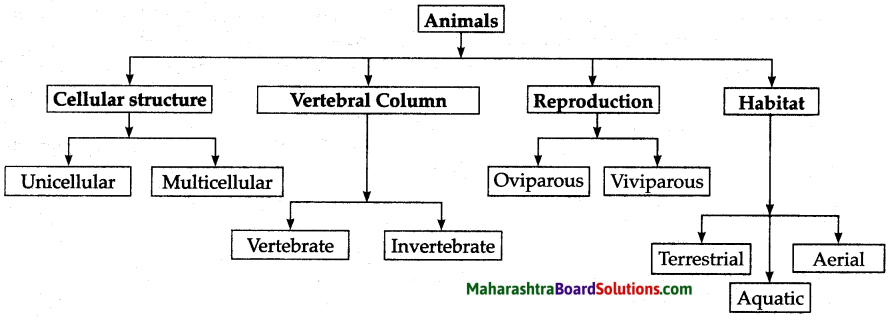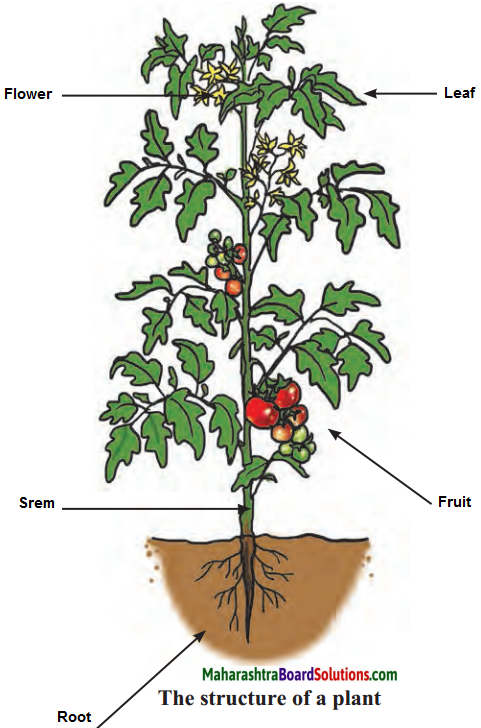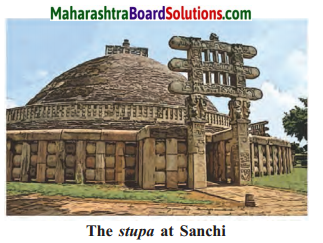Balbharti Maharashtra State Board Class 6 Science Solutions Chapter 15 Fun with Magnets Notes, Textbook Exercise Important Questions and Answers.
Maharashtra State Board Class 6 Science Solutions Chapter 15 Fun with Magnets
Class 6 Science Chapter 15 Fun with Magnets Textbook Questions and Answers
1. How will you do this?
Question a.
Determine whether a material is magnetic or non-magnetic.
Answer:
- To determine whether the material is magnetic or non-magnetic, a magnet is moved over it.
- If the material sticks to the magnet, it is called magnetic material.
- If the material does not stick to the magnet, it is non-magnetic.
![]()
Question b.
Explain that a magnet has a certain magnetic field.
Answer:
- The space around a magnet in which the magnetic force is active is called the magnetic field.
- Place a white paper on a drawing board and place a bar magnet in the middle of the paper.
- Spread the iron filings on the sheet and gently tap the sheet.
- The iron filings arrange around the magnet in definite curved lines forming a symmetric pattern.
- The lines are closer to each other near the poles and less crowded in the middle region around the magnet.
- Beyond a particular region, the iron filings, will not get attracted.
- The region where iron filings are attracted is the magnetic field of the magnets.
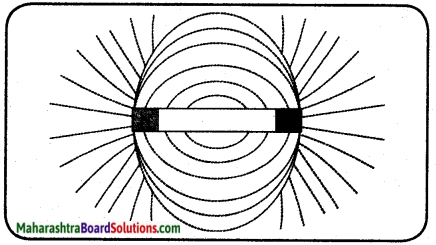
Question c.
Find the north pole of a magnet.
Answer:
- Take a bar magnet. Tie a thread to the centre of a bar magnet and hang it from a stand.
- Note the direction in which the magnet settles and turn it around again.
- Allow it to settle and note the direction.
- The end of the magnet that points to the north is called the north pole, while the end that points to the south is called the south pole.
- The north pole is indicated by ‘N’ and the south pole by ‘S’.

2. Which magnet will you use?
Question a.
Iron is to be separated from a trash.
Answer:
- Sharp and heavy iron scrap material is attached to a big disc.
- The disc is a magnet and all scrap is attracted to it.
- It is not possible to create, store such a big size magnet. Therefore magnetism is induced in the disc with the help of electricity.
An electromagnet is used which is attached to a crane for loading and unloading, transporting scrap and loose iron material from a trash.
![]()
Question b.
You are lost in a forest.
Answer:
- If we are lost in a forest, we should take help of a mariner’s compass which will help us to find the directions while travelling through unknown regions.
- If mariner’s compass is not available, a bar magnet when suspended in the centre will rest in north-south direction.
Question c.
A window shutter opens and shuts continuously in the wind.
Answer:
A bar magnet can be attached to the window pane so that the window will be closed tight during strong winds also.
3. Fill in the blanks with appropriate word.
Question a.
If a bar magnet is hung by a thread tied at its centre, its north pole becomes steady in the direction of the …………… pole of the earth. (south, north, east, west)
Answer:
North
Question b.
If a bar magnet is cut into equal pieces by cutting it at right angles to its axis at two pieces …………… bar magnets are formed, and a total of …………… poles are formed. (6,3,2)
Answer:
3, 6
![]()
Question c.
There is a repulsion between the …………… poles of a magnet and attraction between its ……………. poles. (opposite, like.)
Answer:
like, opposite
Question d.
When magnetic material is taken close to a magnet, the material acquires …………… . (permanent magnetism, induced magnetism, temporary, magnet keeper)
Answer:
induced magnetism
Question e.
If a magnet attracts a piece of metal, that piece must be made of ………… .(any other metal but iron, magnetic material or iron, non-magnetic material, electromagnets)
Answer:
magnetic material or iron
Question f.
A magnet remains steady in a ………….. direction. (east-west, north-south,)
Answer:
north-south
4. Write the answers in your words.
Question a.
How is an electromagnet made?
Answer:
1. To make an electromagnet we need the following apparatus; An iron nail of 10 cm length, 1 metre long insulated copper wire, a battery cell, pins.
2. Wind the copper wire around the nail as shown in the figure. Connect the free ends of the wire to the two terminals of a cell through a plug key.
3. Close the key to complete the circuit.
4. Bring small pins near the tip of the nail and observe.
5. When the circuit is completed, the iron pins are attracted by the nail and hence, they stick to the nail.

6. When the circuit is broken, the pins fall off.
7. A magnet is prepared by passing an electric current through an insulated wire wound around the iron nail. This is an electromagnet.
8. When the current is allowed to pass, the nail becomes a magnet and attracts pin / pins stick to it.
9. When the current is put off the nail does not behave as a magnet and therefore, pins fall off.
10. The magnetism is temporary in the case of an electromagnet.
![]()
Question b.
Write the properties of a magnet.
Answer:
Magnet possess following properties/ characteristics.
- Magnet always settles in the north-south direction.
- The magnetic force is concentrated at the two ends or poles of a magnet.
- If a magnet is divided into two parts, two independent magnets are formed. It means that the two poles of a magnet cannot be separated from each other.
- A magnetic material acquires magnetism when placed near a magnet. This magnetism is called induced magnetism.
- There is repulsion between like poles of a magnet, while there is attraction between the opposite poles.
Question c.
What are the practical uses of a magnet?
Answer:
- Magnets are materials to which objects made from iron, nickel, cobalt are attracted. But man explored magnets and its properties and made his life comfortable.
- Permanent Magnets: are used in caps of pin holders, doors of fridges, doors of cupboards etc.
- Temporary magnets: Electromagnets are used in electric bells, circuit of various machines, ATM card swipe machines, MRI- Magnetic Resonance Image, loudspeakers, electric cranes, microphones, Mariner’s compasses, etc.
Activity
Question 1.
Collect information regarding how the various magnets used in our day-to-day tasks are produced.
Question 2.
Collect information about the magnetism of the earth.
Class 6 Science Chapter 15 Fun with Magnets Important Questions and Answers
Fill in the blanks.
Question 1.
Iron objects ………….. to a magnet.
Answer:
stick
![]()
Question 2.
A magnet is used in ………….. and ………….. .
Answer:
gadgets and machines
Question 3.
The materials that stick to a magnet are called ………….. materials.
Answer:
magnetic
Question 4.
Materials that do not stick to a magnet are called ………….. materials.
Answer:
non-magnetic
Question 5.
When a magnet attracts an object, that object is ………….. due to the magnetic force.
Answer:
displaced
Question 6.
Magnetism is a form of ………….. .
Answer:
energy
![]()
Question 7.
A magnet always settles in the ………….. direction.
Answer:
north-south
Question 8.
The north pole is indicated by’ …………… and the south pole by ‘……………’.
Answer:
‘N’-‘S’
Question 9.
The end of the magnet that points to the north is called the ………….. .
Answer:
Northpole
Question 10.
The end of the magnet that points to the south is called the ………….. .
Answer:
South pole
![]()
Question 11.
The magnetic force is concentrated at the two ends or ………….. of a magnet.
Answer:
poles
Question 12.
If a magnet is divided into two parts, two ………….. magnets are formed.
Answer:
independent
Question 13.
It means that the two poles of a magnet cannot be ………….. from each other.
Answer:
separated
Question 14.
A magnetic material acquires magnetism when placed near a
Answer:
magnet
Question 15.
Iron filling stick to the iron bar when the ………….. is near it.
Answer:
magnet
![]()
Question 16.
There is ………….. between like poles of a magnet.
Answer:
repulsion
Question 17.
There is ………….. between the opposite poles of a magnet.
Answer:
attraction
Question 18.
Magnetic objects ………….. magnetism.
Answer:
induce
Question 19.
Material ………….. is a mixture of aluminium, nickel and cobalt.
Answer:
Alnico
![]()
Question 20.
………….. magnets are made from a mixture of nickel, cobalt and iron.
Answer:
Permanent
Question 21.
The bar of soft or pure iron which protects a magnet is called ………….. .
Answer:
magnet keeper
Question 22.
Magnetism gets ………….. when a magnet is heated, thrown, knocked about or broken into pieces.
Answer:
destroyed
Question 23.
Electromagnetic energy is used in our ………….. life.
Answer:
day-to-day
Question 24.
The metals iron, cobalt, nickel are ………….. materials.
Answer:
magnetic
![]()
Question 25.
………….. is a natural magnet.
Answer:
Magnetite
Match the columns.
Question a.
| Column ‘A’ | Column ‘B’ |
| 1. Iron, nickel, cobalt | (a) Electromagnet |
| 2. Door bell magnet | (b) Permanent magnet |
| 3. Nickel, cobalt, aluminium | (c) Magnetic metal |
| 4. Cupboard magnet | (d) Mariner’s compass |
| 5. Lodestone | (e) Alnico |
Answer:
| Column ‘A’ | Column ‘B’ |
| 1. Iron, nickel, cobalt | (c) Magnetic metal |
| 2. Door bell magnet | (a) Electromagnet |
| 3. Nickel, cobalt, aluminium | (e) Alnico |
| 4. Cupboard magnet | (b) Permanent magnet |
| 5. Lodestone | (d) Mariner’s compass |
State whether true or false. If false, correct the statement.
Question 1.
Material alnico is a mixture of aluminium, nickel and iron.
Answer:
False: Material alnico is a mixture ofaluminium, nickel and cobal.
![]()
Question 2.
Magnetism of electromagnet is permanent.
Answer:
False: Magnetism of electromagnet is temporary.
Question 3.
The bar of soft or pure iron protects the magnet.
Answer:
True
Question 4.
Like poles attract each other and unlike poles repel each other.
Answer:
False: Like poles repel each other and unlike poles attract each other.
Question 5.
The magnetic force is concentrated at the centre of the magnet.
Answer:
False: The magnetic force is concentrated at the poles of the magnet
![]()
Question 6.
Magnetism is a kind of energy.
Answer:
True
Question 7.
Mariner’s compass is used for finding directions while travelling.
Answer:
True
Question 8.
Cobalt is a magnetic material.
Answer:
True
Question 9.
The north pole is indicated by ‘S’ and the south pole is indicated by ‘N’.
Answer:
False: The north pole is indicated by Wand the south pole is indicated by ‘S’.
![]()
Question 10.
Electromagnetism is used in many places in our day-to-day life.
Answer:
True
Answer the following questions in one sentence.
Question 1.
What is a magnet?
Answer:
The material to which objects made from iron, nickel, cobalt get attracted is called as magnet.
Question 2.
What is magnetism?
Answer:
The property of a material to which objects made from iron, nickel, cobalt get attracted is called as magnetism.
Question 3.
What are magnetic materials?
Answer:
Materials that stick to a magnet are called magnetic materials, e.g. cobalt, nickel, iron.
Question 4.
What are non-magnetic materials?
Answer:
Materials that do not stick to a magnet are called non-magnetic material, e.g. plastic, rubber, glass etc.
![]()
Question 5.
What are lodestones?
Answer:
Lodestones are leading stones which are used for finding the directions while travelling through unknown regions.
Question 6.
How is magnetism a kind of energy?
Answer:
Work is done by magnetic force. Thus, magnetism is a kind of energy.
Question 7.
What is an electromagnet?
Answer:
When magnetism is produced in the iron due to the electric current, it is called an electromagnet.
Question 8.
How are permanent magnets made?
Answer:
Permanent magnets are made from a mixture of nickel, cobalt and iron.
Question 9.
List the instruments where electromagnets are used.
Answer:
Electromagnets are used in doorbells, cranes, loudspeakers, voltameters, TVs, antennas, radios etc.
![]()
Question 10.
How is magnetism destroyed?
Answer:
When magnets are heated, thrown, knocked about or broken into pieces, magnetism gets destroyed.
Question 11.
What is a magnet keeper?
Answer:
A magnet keeper is a bar of soft or pure iron which protects a magnet. It is a piece of soft iron placed in the box in which a magnet is kept.
Question 12.
Magnets exist in variety of shapes.
Answer:
Today, magnets are used in many machines, gadgets and devices. They are all man-made. Hence, they can have a variety of shapes depending upon their use.
Answer the following briefly.
Question 1.
What are leading stones?
Answer:
- It was known quite long ago to the people in China and Europe that a piece of magnetite, hung freely always settled in the north-south direction.
- These rocks then came to be used for finding the directions while travelling through unknown regions.
- That is why they are called leading stones or Lodestones.
![]()
Question 2.
What has led to the invention of the Mariner’s compass?
Answer:
Leading stones have led to the invention of the mariner’s compass.
Question 3.
List the different shapes of magnets.
Answer:
- Magnets have a variety of shapes depending on their uses.
- They are bar magnets, disc magnets, horseshoe magnets, ring shaped magnets, cylindrical magnets, and small button magnets.
Question 4.
What are permanent magnets?
Answer:
- Magnets which do not lose their magnetism easily are called permanent magnets or Magnets which are made up of magnetic substances are permanent magnets.
- e.g. Magnets fixed in a pin holder, magnets of a door of a cupboard are permanent magnets.
- Permanent magnets are made from a mixture of
- Nickel, cobalt, iron
- Aluminium, nickel, cobalt – alnico
Give scientific reasons.
Question 1.
Why is it important to place a magnet keeper in a box along with magnets?
Answer:
Magnetism gets destroyed when a magnet is heated, thrown, knocked about or broken into pieces. A magnet keeper which is a bar of soft or pure iron protects a magnet.
![]()
Question 2.
Cranes with magnets are used.
Answer:
When a magnet attracts an object, that object is displaced due to the magnetic force. In factories, ports, garbage depots, large objects are lifted and shifted from place to place using cames. Hence cranes are fitted with magnets.
Can you tell?
Question 1.
Pins in a pin holder do not fall? While we are shutting the door of a fridge, we find that it closes automatically from certain distance and does not open unless pulled again.
Answer:
Magnet is fitted in the cap of a pin holder and in the door of a fridge. Iron objects stick to the magnet.
Question 2.
Take a magnet from the laboratory and bring it near various objects in your use. Which of them stick to the magnet? What material is each of them made of? Observe these things carefully. Classify the objects into two groups: those which stick to the magnet, those which do not.
Comb, table, cupboard – iron, spoon, scissors, pen, pencil, eraser, books, mobile, laptops, glass bangles, hair pin, cupboard handle, chair, steel lunch box, magnetic stickers, toys, gold ring.
Answer:
| Stick to the magnet | Doesn’t stick to the magnet |
| Iron cupboard, spoon, scissors, hairpin, steel lunch box, magnetic stickers | Comb, table, pen, pencil, eraser, books, glass bangles, chair, mobile, laptops, cupboard handle, toys, gold ring |
![]()
Question 3.
Take a mixture of sand, pieces of paper, sawdust, iron filings and pins in a saucer and pass a magnet around the mixture. What do you see?
Answer:
When magnet is moved over a mixture of sand, pieces of paper, sawdust, iron filings and pins, pins and iron filings will cling to the magnet. Sand, sawdust and pieces of paper will remain behind.
Question 4.
How is a Mariner’s Compass used?
Answer:
- A Mariner’s Compass is a magnetic needle used in navigation to show direction by deflections.
- It is a direction-finding instrument used in navigation.
- It is placed on the maps, grounds, decks as it will point to the magnetic north pole.
- It has two or more magnets permanently attached to a compass card which moves freely on a pivot.
- The needle fixed on the compass bowl indicates the ship’s heading position.
Question 5.
Find out where the magnet given are used?
Answer:
| Magnets | Uses |
| Horseshoe magnet | used in electric bell |
| Circular magnet | used in loudspeaker. |
| Magnetic needle | used in Mariner’s Compass. |
| Disc magnets | used in toys |
| Bar magnets | used in cupboard doors |
| Button magnet | supporting side rails or blockouts |
| Square magnet | Industries |
| Arc magnet | Electric motors and generators. |
| Cylindrical magnet | used in medicine, used in treatment of scoliosis patients. |
![]()
Question 6.
Identify the different types of magnets as shown in the picture below.
Answer:
a. Circular magnet
b. Cylindrical magnet
c. Horseshoe magnet
d. Bar magnet

